Early colonization: Australian horticulture
Sydeny's Botanic Gardens are very park-like, open to the harbour, and enjoyed by picknickers and playing children. There are few formal garden areas. Of especial interest, however, was a pioneer garden of the plants that the early settlers tried to cultivate, many of which failed, forcing them to explore native alternatives. Also of note were the enormous daytime-flying fruit bats!
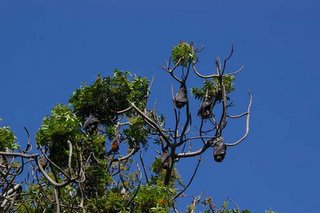
The following week, in Melbourne's Botanic Gardens, I was struck by how much of it looked like a botanic garden in England, with sweeping lake vistas worthy of Capability Brown, formal rose gardens and traditional herbaceous borders. There was, however, a hill garden all in silver, planted with mostly native drought-tolerant plants, and a native fern gully.
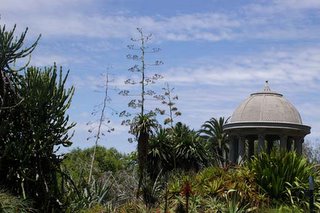
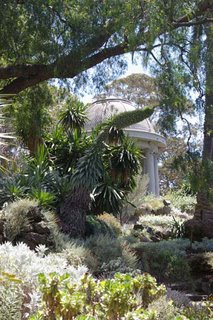
As Trisha Dixon notes in her 1991 book Garden Design and Style, "for many early settlers, the environment was foreign and harsh, and they quickly tried to make it look as English as possible. Early paintings show how native vegetation was completely overlooked. The native eucalypts were too subtle in their form and beauty to be appreciated" (p. 43).
Others before the settlers had been more appreciative. Joseph Banks, the famous founder of Kew, and Sydney Parkinson, one of the best known of all botanical illustrators, were fascinated by the Australian flora on their voyage with Captain Cook in the 1770's. They took every opportunity to collect, classify, and illustrate as many of the unfamiliar plants as they could, a tremendous undertaking. When a BBC crew re-created a small portion of the historic voyage in 2001, they had a glimpse of the conditions and accomplishments of the original crew. Lucy Smith, the contemporary botanical illustrator, wrote in her journal: "The volume and pressure of the work is giving me the faintest idea of how Parkinson must have felt, although at two specimens a day, I'm hardly competing with his one-time total of 94 in 14 days!" (Baker, The Ship: Retracing Captain Cook's Endeavour Voyage, 2002, p. 102).
Whether or not early settlers to Australia had ever seen Parkinson's beautiful paintings, they were obviously keen to familiarize their surroundings with very British gardens, at least at first: "Many early settlers perhaps felt threatened by the unfamiliar territory and so attempted to make an oasis of exotica totally enclosed and separate from the wider landscape...such gardens form the basis of much of Australia's garden heritage" (Dixon, 1991, p. 27-28).
Eventually, however, the changing attitudes of English gardening filtered down to the Australian colony. "The Robinsonian school of thought...soon made its way to Australia....[but] it was not until Edna Walling and William Guilfoyle started incorporating 'wild gardens' into their designs that Australians started to form an appreciation of their native flora. Guilfoyle believed the Australian wild garden should not be an imitation of those made in England and should, instead, be enriched with our own horticultural abundance. In this way, he incorporated much of the native vegetation, together with bulbs from South Africa, shrubs from New Zealand, and many other subtropical plants from around the globe" (Dixon 1991, p 43-44). This willingness to blend plants from around the world is still very much in evidence in Australia, with (for example) a formal English rose garden often being interplanted with S. African agapanthus. As with most home gardeners, the goal seems to be beauty rather than any kind of horticultural purism--and the blue and white agapanthus do provide a gorgeous complement to red and pink roses! As Dixon points out, however, "nostalgia for old world gardens is tied closely with our yearning for days long past"! (1991, p. 79).
While in Australia, I visited a private garden that is now state-owned, the George Tindale gardens on Mt. Dandenong (Victoria). This extensive garden is a perfect example of the uneasy blend of native and traditional flora, in that a large portion of it has had to be fenced off due to the danger from falling limbs from the giant eucalyptus trees that surround the garden plantings. On the day I visited, the garden was deserted, and it felt as if the Australian forest was overtaking what the garden-makers had struggled to create in their midst. The towering eucalyptus and native grasses were encroaching into the carefully enclosed, rather formal garden beds full of bright English perennials and shrubs. The only sign of some longevity of the formal plantings was the size of the gorgeous hybrid mophead and lacecap hydrangeas that bloomed throughout the woods in all shades of pink, plum, and blues from pale to intense. It was a sad place, and made me very aware that gardens seldom outlive the gardener--the 'wild' will overgrow the cultivated in short order!
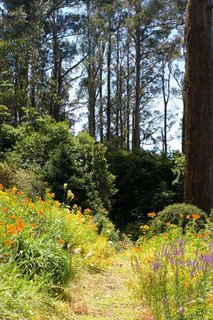

On the same day, however, I visited another private-turned-public garden nearby, the Alfred Nicholas garden. This garden was situated on a steep slope with a natural lake at the bottom and, although much of the layout was that of a European country estate (complete with islands in the lake connected by Monet-like bridges), the planting was almost wholly native, and well-selected for this shady site. The vegetation consisted mostly of ferns and mosses, with only an occasional exotic shrub such as fuchsia or hydrangea for a little colour. The exotic was represented by willows, robinias, Japanese maples, and other trees surrounding the lake edge, but these were well-integrated among the native trees and shrubs. The mood in this garden was quite different, settling comfortably into its surroundings and feeling quite timeless.
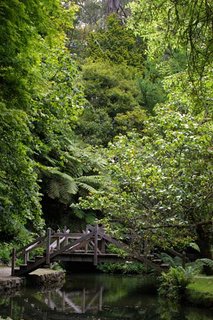
On that same day, I purchased a book about Edna Walling, one of Australia's most influential garden designers in the last century. I will explore a remaining example of Walling's work in the next entry.

0 Comments:
Post a Comment
<< Home